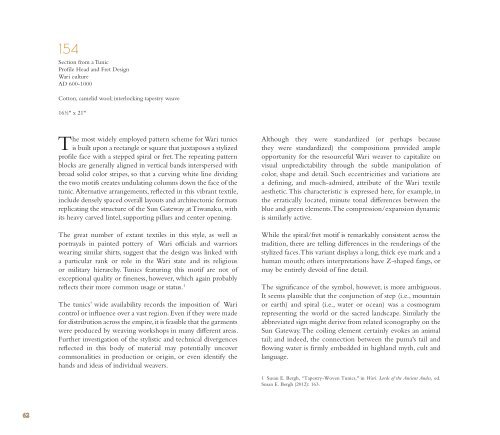Create successful ePaper yourself
Turn your PDF publications into a flip-book with our unique Google optimized e-Paper software.
154<br />
Section from a Tunic<br />
Profile Head and Fret Design<br />
Wari culture<br />
AD 600-1000<br />
Cotton, camelid wool; interlocking tapestry weave<br />
16½" x 21"<br />
The most widely employed pattern scheme for Wari tunics<br />
is built upon a rectangle or square that juxtaposes a stylized<br />
profile face with a stepped spiral or fret. The repeating pattern<br />
blocks are generally aligned in vertical bands interspersed with<br />
broad solid color stripes, so that a curving white line dividing<br />
<strong>the</strong> two motifs creates undulating columns down <strong>the</strong> face of <strong>the</strong><br />
tunic. Alternative arrangements, reflected in this vibrant textile,<br />
include densely spaced overall layouts and architectonic formats<br />
replicating <strong>the</strong> structure of <strong>the</strong> Sun Gateway at Tiwanaku, with<br />
its heavy carved lintel, supporting pillars and center opening.<br />
The great number of extant textiles in this style, as well as<br />
portrayals in painted pottery of Wari officials and warriors<br />
wearing similar shirts, suggest that <strong>the</strong> design was linked with<br />
a particular rank or role in <strong>the</strong> Wari state and its religious<br />
or military hierarchy. Tunics featuring this motif are not of<br />
exceptional quality or fineness, however, which again probably<br />
reflects <strong>the</strong>ir more common usage or status. 1<br />
The tunics’ wide availability records <strong>the</strong> imposition of Wari<br />
control or influence over a vast region. Even if <strong>the</strong>y were made<br />
for distribution across <strong>the</strong> empire, it is feasible that <strong>the</strong> garments<br />
were produced by weaving workshops in many different areas.<br />
Fur<strong>the</strong>r investigation of <strong>the</strong> stylistic and technical divergences<br />
reflected in this body of material may potentially uncover<br />
commonalities in production or origin, or even identify <strong>the</strong><br />
hands and ideas of individual weavers.<br />
Although <strong>the</strong>y were standardized (or perhaps because<br />
<strong>the</strong>y were standardized) <strong>the</strong> compositions provided ample<br />
opportunity for <strong>the</strong> resourceful Wari weaver to capitalize on<br />
visual unpredictability through <strong>the</strong> subtle manipulation of<br />
color, shape and detail. Such eccentricities and variations are<br />
a defining, and much-admired, attribute of <strong>the</strong> Wari textile<br />
aes<strong>the</strong>tic. This characteristic is expressed here, for example, in<br />
<strong>the</strong> erratically located, minute tonal differences between <strong>the</strong><br />
blue and green elements. The compression/expansion dynamic<br />
is similarly active.<br />
While <strong>the</strong> spiral/fret motif is remarkably consistent across <strong>the</strong><br />
tradition, <strong>the</strong>re are telling differences in <strong>the</strong> renderings of <strong>the</strong><br />
stylized faces. This variant displays a long, thick eye mark and a<br />
human mouth; o<strong>the</strong>rs interpretations have Z-shaped fangs, or<br />
may be entirely devoid of fine detail.<br />
The significance of <strong>the</strong> symbol, however, is more ambiguous.<br />
It seems plausible that <strong>the</strong> conjunction of step (i.e., mountain<br />
or earth) and spiral (i.e., water or ocean) was a cosmogram<br />
representing <strong>the</strong> world or <strong>the</strong> sacred landscape. Similarly <strong>the</strong><br />
abbreviated sign might derive from related iconography on <strong>the</strong><br />
Sun Gateway. The coiling element certainly evokes an animal<br />
tail; and indeed, <strong>the</strong> connection between <strong>the</strong> puma's tail and<br />
flowing water is firmly embedded in highland myth, cult and<br />
language.<br />
1 Susan E. Bergh, “Tapestry-Woven Tunics," in Wari. Lords of <strong>the</strong> <strong>Ancient</strong> <strong>Andes</strong>, ed.<br />
Susan E. Bergh (2012): 163.<br />
62







